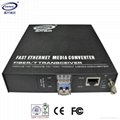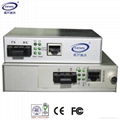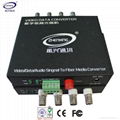1. Fiber media converter is designed to extend the cooper limit of 100 meters and gets Ethernet connected to 120km max on fiber optics. Also refer to as fiber converter, media converter, or Ethernet fiber converter, fiber media converter is a simple networking device that connects two dissimilar media types such as cooper twisted pair and fiber optics.
2. Fiber media converter supports many different data communication protocols including Ethernet, Fast Ethernet, Gigabit Ethernet, T1/E1/J1, DS3/E3, as well as multiple cabling types such as coax, twisted pair, multi-mode and single-mode fiber optics. Media converter types range from small standalone devices to high port-density chassis systems that offer abundant advanced features for network management. Simple Network Management Protocol (SNMP) enables proactive management of link status, monitoring chassis environmental statistics and sending traps to network managers in the event of a fiber break or even link loss on the copper port. Apart from SNMP managed fiber media converters are in full compliance with WEB GUI, TELNET and CONSOLE protocols
3. When expanding the reach of the LAN to span multiple locations, media converters are useful in connecting multiple LANs to form one large "campus area network" that spans over a limited geographic area. As premises networks are primarily copper-based, media converters can extend the reach of the LAN over single-mode fiber up to 120 kilometers with 1550 nm optics.
4. Wavelength Division Multiplexing (WDM) technology is especially beneficial in situations where fiber access is in limited or expensive. WDM fiber media converters receive and transmit data on the same fiber while conventional media converters transmit and receive on separate ports.
5. SFP fiber media converters, which use SFP transceivers instead of fixed mounted 1*9 optical modules, maximize media converters' flexibility in wavelength, rates, and fiber type.
6. Other benefits of media conversion include providing a gradual migration path from copper to fiber. Fiber connections can reduce electromagnetic interference.
| Standard |
|
RJ-45 Port |
Auto-MDI/MDIX |
| IEEE802.3 (10BASE-T) |
|
Fiber Connector |
SC standard, ST/FC optional |
| IEEE802.3u 100BASE-TX/FX (Fast-Ethernet) |
|
Wavelength |
1310/1550nm |
| IEEE802.3ab 1000BASE-TX (Gigabit Ethernet) |
|
Dimensions |
138mm(W) x 179mm(D) x 34mm(H) |
| IEEE802.3z 1000BASE-SX/LX (Gigabit Ethernet) |
|
Weight |
Net weight : 0.666kg |
| IEEE802.3x (Flow Control) |
|
Gross weight : 0.984kg |
| IEEE802.1q, IEEE802.1p QoS, IEEE802.1d Spanning Tree |
|
Input Voltage |
AC100 ~ 240V / 50-60HZ
(Internal power supply) |
| 10/100/1000BASE-T : |
|
|
| STP or UTP Category 5/5e/6 cable (Max. 100m) |
|
Power Consumption |
<2.5W |
| SFP : |
|
MTBF |
50,000 hours |
| SX, LX, EX, ZX, EZX |
|
BER |
<1/1000000000 |
| and Bi-D optical transceivers are available |
|
Operati on |
0~50 Celsius |
| Conversion M ode / D elay T ime |
|
Storage |
-40~70 Celsius |
| Store-and-Forward < 10us, straight-through<0.9us |
|
Storage Humidity |
5%~90% non-condescending |
| Flow control |
|
MAC Address Table |
1K |
| Full duplex-flow control, Half duplex-back pressure |
|
Buffer Size |
1M |










